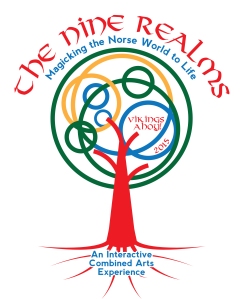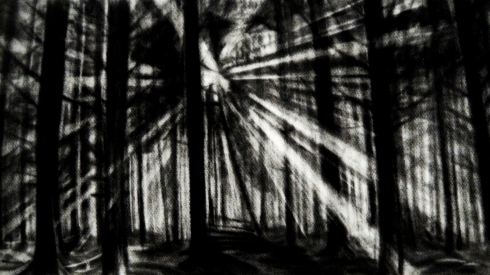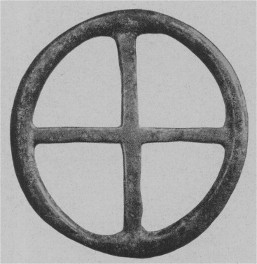The Nine Realms
9 months, 22 poets and writers, 22 Artists, 3 composers, 1 Viking boat= a magical reworking of Norse Mythology for contemporary audiences
—
Alfheim
(the realm of the Light Elves)
Vikings Ahoy!
Here we are in early June with the deadline for the poetry and writing for the 8th realm Midgard having just passed on Friday 5th June ! Who’d have thought we would now be on the final realm!
From this week onwards I will be posting out Midgard poetry.
This month we are outlining the final Norse realm of Alfheim. The final deadline for all writing, poetry and mp3s for this realm is Friday 19th June 2015. I can hardly believe that this is the final realm. Congratulations to all the Viking poets for their creativity, interest and perseverance!!
These monthly posts will draw from a range of primary and secondary source materials and focus on selected gods, themes and stories that circle around the highlighted realm. They will not attempt to cover everything, and writers can embrace any other stories and characters within their writing which is not covered. Month by month we will be building our own magical, contemporary norse world whilst exploring the themes of POWER, NATURE and RELIGION. The project’s overall intention is to embrace orality, translation, storytelling and rhythm all of which are inspired by the origins of the oral tradition of the Norse Sagas.
I may well put out little mini-posts intermittently focusing on orality and poetic form as necessary.
What is presented below is designed to inspire, present basic information and offer a starting point for individual creativity within the project inspired by the themes, characters and spirit of the myths and stories.
.
.
1. A Brief Overview of Alfheim
.
It is often said that there are two sorts of elves in Norse mythology: the Dark Elves and the Light Elves. The Light Elves are said to live in Alfheim near the gods’ halls and palaces. In old Norse, Ālfheimr, is known as ‘Land of the Fairies’. Alfheim is quite an elusive realm, and is only mentioned twice in the Norse Saga texts, making the realm quite hard, in actuality, to bring to life. The god Freyr is said to be the ruler of Alfheim. Elves, along with Freyr, are generally associated with the sun (Ellis Davison: 156). This derives from ‘a kenning for the sun, álfrǫðull…to some suggestive of a close link between the elves’. (Motz 1973, p. 99; Hall 2004, p. 40.)
Scholars of Old Norse mythology now focus on references to elves in Old Norse poetry, particularly the Elder Edda. The only person explicitly identified as an elf in classical Eddaic poetry, if any, is Völundr, the main character in the Völundarkviða However, elves are frequently mentioned in the sequence of words: Æsir ok Álfar (‘Æsir and elves’). This sequence shows a strong tradition of an association between the elves with the Æsir.
See: http://en.wikipedia.org/wiki/%C3%81lfheimr
.
.
- Meadow Elves
- Freyr, The Fertility God
.
The two references two elves within the Edda texts are as follows:
1. In the eddic text Grímnismál, describing 12 divine residencies of the gods
in stanza 5 :
Ýdalir call they the place where Ull
A hall for himself hath set;
And Álfheim the gods to Frey once gaveAs a tooth-gift in ancient times.
nb. A tooth-gift was a gift given to a child on the cutting of the first tooth.
You can find the whole Grímnismál here
2. In the Gylfaginning of The Prose Edda:
‘That which is called Álfheim is one, where dwell the peoples called ljósálfar [Light Elves]; but the dökkálfar [Dark Elves] dwell down in the earth, and they are unlike in appearance, but by far more unlike in nature. The Light-elves are fairer to look upon than the sun, but the Dark-elves are blacker than pitch. There are in fact some references that there are three places within the heavens where the light elves live: Gimlé, Andlàngr and Víðbláinn. This information is passed onto the king of Gylfi by a figure called High.’
You can find the whole Gylfaginning here.
.
For more information on the history of elves see: http://en.wikipedia.org/wiki/Elf
.
For more details on Dökkálfar and Ljósálfar see http://en.wikipedia.org/wiki/D%C3%B6kk%C3%A1lfar_and_Lj%C3%B3s%C3%A1lfar
.
.
2. Story Focus: Lovelorn Freyr
.
- Freyr on Odin’s Throne
- Skirnir
.
Freyr goes to Hlidskjálf (the high seat of Odin which allows him to see all the realms~). He gazes across the realms and sees Gerðr the giantess with whom he falls immediately in love. Rather than becoming full of joy he broods and ruminates. Opening up to his page Skírnir, he asks Skirnir to woo Geror for him.
.
| Þá svarar Skírnir, sagði svá at hann skal fara sendiferð en Freyr skal fá honum sverð sitt. Þat var svá gott sverð at sjálft vásk. En Freyr lét eigi þat til skorta ok gaf honum sverðit. Þá fór Skírnir ok bað honum konunnar ok fekk heitit hennar, ok níu nóttum síðar skyldi hon þar koma er Barey heitir ok ganga þá at brullaupinu með Frey. Gylfaginning 37, EB’s edition | Then Skírnir answered thus: he would go on his errand, but Freyr should give him his own sword-which is so good that it fights of itself;- and Freyr did not refuse, but gave him the sword. Then Skírnir went forth and wooed the woman for him, and received her promise; and nine nights later she was to come to the place called Barrey, and then go to the bridal with Freyr. Gylfaginning XXXVII, Brodeur’s translation |
S
.
As mentioned above, Skrinir asks for Freyr’s sword in return. This request has apocalyptic consequences as Freyr does not have his sword to fight Surt at Ragnarök .
.
3. Völundr, the main character in the Völundarkviða in the Poetic Edda (see overview above)
.
.
Volundr is an artisan and is said to be one of the three sons of the king of the Finns. He is called “prince of the elves” (vísi álfa) and “one of the álfar” or “leader of álfar”.
So the story goes, his wife Hervör-Alvitr, a valkyrie (“chooser of the slain”), abandons him after nine years of marriage. He is then captured by Níðuðr, a cruel-king of Närke (Sweden) who is out to get Völundr’s gold. Völundr is put to work on an island making artifacts for the king. Eventually he finds means to take revenge and escapes. He kills Niðuðr’s sons, impregnates his daughter and then flies away laughing.
http://en.wikipedia.org/wiki/V%C3%B6lundarkvi%C3%B0a
You can find the full Völundarkviða here
.
4. Fertility Ceremonies and the Elves
.
.
There is a story of an early King of Norway called Olaf, to whom, In a times of scarcity, men sacrificed. This is stated in Flaseyjarbok, one of the largest medieval manuscripts. At times of famine they also sacrificed to Freyr as the god of fertility. ‘When Olaf the Holy was born, he was named after the earlier Olaf. He was christend ‘Olaf, Elf of Geirstad’ [11, 106]. Viking burials quite often seemed to be connected with elves, right into the late Viking age (Ellis-Davidson: 155-156). This is seen to be evidence of the connection between fertility, elves and Freyr.
.
.
Another mention…Sigvat, a poet who served under King Olaf the Holy, in 1018, describes how the king could not find a place to stay because everyone was too busy sacrificing to elves.
Cupmarks on rocks and stones are found in association with sunwheels. Farmers have often poured milk into similar cups as offerings to the elves.
.
Themes, Relevance and Questions
.
Good versus evil
It has been suggested that this classification of the two types of elves has come in as part of the influence of Christianity. A division of good and evil, light and dark. To consider this in relation to notions of power, fairness and spirituality within The Prose and Poetic Eddas is an interesting notion.
Exploration Point: What other examples of dualism, or contrasts can you find in the Eddas and how are they used to comment on the world and the heavens?
Things of Interest:
.
1. The Speech of Elves
J. R. R. Tolkien anglicized Álfheim as Elvenhome, or Eldamar in the speech of the Elves. In his stories, Eldamar lies in a coastal region of the Undying Lands in the Uttermost West. The High King of the Elves in the West was Ingwë, an echo of the name Yngvi often found as a name for Frey, whose abode was in Álfheim according to the Grímnismál.
For an Interview with Tolkien from 1968 go to: https://youtu.be/DFcjBzP7H-E
2. Light-elves, Dark-elves, and Others: Tolkien’s Elvish Problem by Tom Shippey
http://muse.jhu.edu/journals/tolkien_studies/v001/1.1shippey.html
3. Norse Elements in the work of J.R.R. Tolkien
.
.
4. Drawing Lessons: How to draw Elves
.
.
5. Prospero’s Speech from The Tempest : ‘Ye elves of hills, brooks, standing lakes, and groves’
.
6. Words For Sentient Beings From Norse Texts
.
http://en.wikipedia.org/wiki/Elf#Old_Norse_texts
.
Optional Poetry and Writing Prompts:
.
Luc Bat
A Vietnamese verse form. Where lines of 6 syllables alternate with lines of 8 syllables. The name Luc Bat means six-eight. The rule is that each rhyme occurs three times – first at the end of an 8-syllable line, then at the end of the next 6-syllable line, and finally as the sixth syllable of the next 8-syllable line. The end loops back to the beginning. They can be both long and short.
See here for more details.
Writing Word Prompts: Song, Hope, Motion, Contempt, Time, Darkness, Haunting, Magic, Heavens, Memory
.
To confirm, the deadline for all writing, poetry and mp3s for the Alfheim realm is Friday 19th June 2015.
.
Thank you so much for your interest. Do keep an eye out for more of The Nine Realms project updates.
.
References
Allan, T (2010) Vikings, The Battle at the End of Time, London: Watkins Publishing
Crossley-Holland, K (1993) The Penguin Book of Norse Myths: Gods of the Vikings, London, Penguin Books
Ellis Davidson, H.R. (1990) Gods and Myths of Northern Europe, Penguin Books
Hollander, L.M. (1996) tr. The Poetic Edda, Austin: University of Texas Press
Larrington, C. (1996) tr. The Poetic Edda, Oxford University Press
Sturluson, S. (2005) The Prose Edda, Penguin Classics, tr. Jesse L. Byock























































Just love the words from Norse texts being presented in a Venn diagram – brilliant!